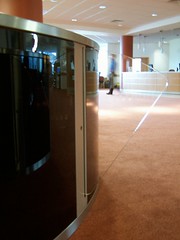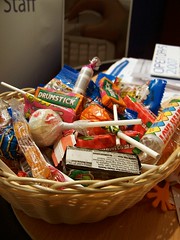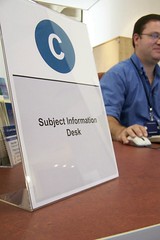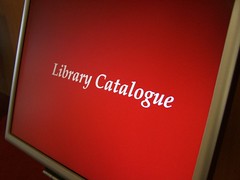The University of Hudderfield Library is entering into the 2nd phase of a 3 year refurbishment. Last year, it was the entrance floor, and this year it’s the two subject floors above. Floor 5 is already cleared of stock, and floor 6 will be empty by the end of next week.
I couldn’t resist spending a few minutes wandering around the deserted floor 5 this afternoon. Most times of the year, it’s a vibrant and busy subject floor — today is was eiree and desolate. With the shelving and staff gone, you get a real sense of the space and size…


The floor of the former PC room is dotted with circular patches where the culmulative effect of hundreds of students on PC swivel chairs has gradually worn away the carpet. It’s like something out of a sci-fi film where people get zapped and turned into a small round pile of ash 😉

You can find the rest of the photos here.






Category: Huddersfield Uni
2008 — The Year of Making Your Data Work Harder
Quite a few of the conversations I’ve had this year at conferences and exhibitions have been about making data work harder (it’s also one of the themes in the JISC “Towards Implementation of Library 2.0 and the E-framework” study). We’ve had circ driven borrowing suggestions on our OPAC since 2005 (were we the first library to do this?) and, more recently, we’ve used our log of keyword searches to generate keyword combination suggestions.
However, I feel like this is really just the tip of the iceberg — I’m sure we can make our data work even harder for both us (as a library) and our users. I think the last two times I’ve spoken to Ken Chad, we’ve talked about a Utopian vision of the future where libraries share and aggregate usage data 😀
There’s been a timely discussion on the NGC4Lib mailing list about data and borrower privacy. In some ways, privacy is a red herring — data about a specific individual is really only of value to that individual, whereas aggregated data (where trends become apparent and individual whims disappear) becomes useful to everyone. As Edward Corrado points out, there are ways of ensuring patron privacy whilst still allowing data mining to occur.
Anyway, the NGC4Lib posts spurred me on into finishing off some code primarily designed for our new Student Portal — course specific new book list RSS feeds.
The way we used to do new books was torturous… I’ve thankfully blanked most of it out of my memory now, but it involved fund codes, book budgets, Word marcos, Excel and Borland Reportsmith. The way we’re trying it now is to mine our circulation data to find out what students on each course actually borrow, and use that to narrow down the Dewey ranges that will be of most interest to them.
The “big win” is that our Subject Librarians haven’t had to waste time providing me with lists of ranges for each course (and with 100 or so courses per School, that might takes weeks). I guess the $64,000 question is would they have provided me with the same Dewey ranges as the data mining did?
The code is “beta”, but looks to be generating good results — you can find all of the feeds in this directory: https://library.hud.ac.uk/data/rss/courses/
If you’d like some quick examples, then try these:
- Entrepreneurship MSc (course details)
- Management by Action Learning MA (course details)
- Youth and Community Work BA(Hons) (course details)
- Performing Arts (Performance) FdA (course details)
- Early Primary Education BA(Hons) (course details)
- Logistics and Supply Chain Management BSc(Hons) (course details)
- Fashion Design (Top-up) BA(Hons) (course details)
- Product Design BA/BSc(Hons) (course details)
Is your data working hard enough for you and your users? If not, why not?
decorative tag cloud
It’s not often that I’d consider adding pure “eye candy” to the OPAC, but I couldn’t decide what would be the best way of making this tag cloud functional. So, I made an executive decision and decided it shouldn’t be functional 😀
If you run a keyword search on our OPAC, at the foot of the page you should see a keyword cloud (it might take a few seconds to appear). The cloud is generated from previous keyword searches used on our OPAC. Here’s the one for “library“…

For multi-keyword searches, an electronic coin is tossed and you either get a cloud of the union or the intersection of your keywords. The former uses previous searches that contain any of the keywords, and the later is only those that contain all of them (if that makes sense!)
As it’s not functional, the cloud is just a decorative window into the hive mind of our users.
I’m interested to hear what you think — should the cloud be functional, or does it work as just “eye candy”?
Congratulations “City of God” DVD!
Sitting in the Short Loan collection in the main library at the University of Huddersfield, it doesn’t really stand out as been any different to the other DVDs near it, but our copy of “City of God” is officially the most borrowed item from our entire collection (which is nearly 400,000 items) in the last 3 years.
It’s not quite as popular as it once was (the number of loans in 2007 was about half of the 2005 figure), but it’s now been borrowed 157 times since it first arrived here in 2004.
The most borrowed book was one of the copies of “Research methods for business students“, which has now been borrowed 118 times since it was first placed on our shelves.
Anyway, if you were thinking of rushing here to borrow “City of God”, sorry — it’s out on loan at the moment 🙂
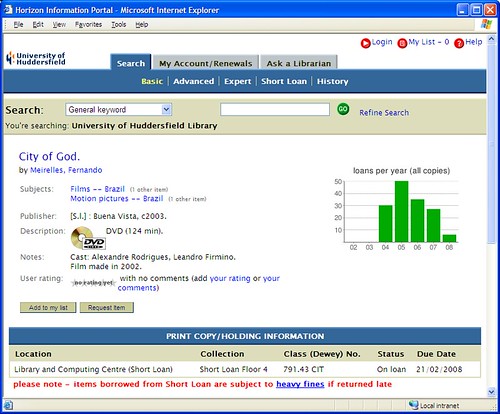
(if you were wondering, then “yes, that’s a Google Chart“)
Ooops – did I just delete the LMS database?
I’m always wary of doing bulk changes to the bibliographic records via SQL, so I tend to be fairly cautious.
Anyway, we’d got nearly 100,000 bib records that need rejiggering (ISBN in the wrong field), so I knocked up a Perl script to do the deed. After it had changed a few hundred records, I connected to the database and ran the following SQL…
set rowcount 10
select * from bib where tag = “011”
The last thing I want to do is pull back everything with a 011 tag, so the “set rowcount” ensures only the first 10 results are returned. The output looks good, so I decide to check the size of the transaction log…
sp_dbspace
We use Sybase and that command shows the size of the main LMS database and the transaction log. The transaction log size looks fine and I minimise the window. However, my subconscious shouts out “something’s wrong!”, so I maximise the SQL window and look at the output again…
name: horizon
data MB: 5500.00
used MB: 54.68
percent: 0.99%
log MB: 300.00
log used MB: 88.40
log pct: 29.47%
My eyes automatically jump to the end of the output: “So, the transaction log is 29.47% full… that’s nothing to worry about…”
My eyes then wander up and my brain takes about 2 seconds to spot what’s really wrong — our entire LMS database is just 54.68MB!!! “That can’t be right… it should be at least 4,800MB!!!”
The colour drains from my face as the possibility that one of the SQL commands in my Perl script has nuked our entire database enters my mind. I sit motionless in my chair waiting for the inevitable phone call from a member of staff: “Dave… is there something wrong with Horizon?”
Then, in the space of about 30 seconds, I go through all seven stages of grief…
1) shock (“I can’t believe this has happened”)
2) denial (“maybe someone else did it?”)
3) bargaining (“I wonder if I can bribe someone else to take the blame?”)
4) guilt (“OMG — IT’S ALL MY FAULT!!!”)
5) anger (“damn it — this didn’t happen when I ran the script on the test database!”)
6) depression (“this won’t sound good when I apply for a new job and they asked me why I was fired from my previous job”)
7) acceptance and hope (“the time is right for a major career change”)
…so, can anyone guess what happened next?
“Spin, spin, spin the Wheel of Justice…”
Kudos if you automatically sang to yourself “…see how fast the bastard turns” 😉
If you’ve no idea what I’m on about, then YouTube is your friend.
Anyway, I got to playing around with the OPAC keyword cloud data and ImageMagick and came up with this (reload that web page to get a new image)…

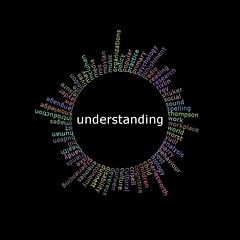



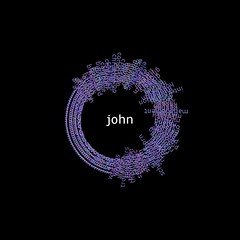
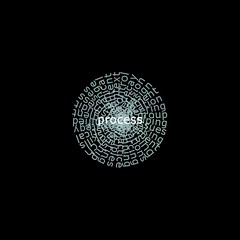

I was struggling to remember how to find the points on the circumference of a circle until I remembered that one of the chapters in the original ZX Spectrum manual covered the topic.
The word in the middle is chosen at random from the top 200 most popular keywords used on our OPAC and the surrounding words at those most commonly used with that word.
“Engaging the Xbox generation of Learners in Higher Education”
Just a little pointer towards a report recently released by Jebar Ahmed and Mary Sheard in the School of Education at the University of Huddersfield:
New generation learners seem to be surrounded by technologies everywhere, at home, at school and in their pockets. Computers and interactive white boards are available in the classrooms, but how do these learners engage with technologies to actually learn? And what can we learn from them to inform teaching in HE?
The Executive Summary is available here.
Patrick Stewart in the Library
It’s not every day that you get a former Captain of the starship Enterprise in your Library, but today was one of those days! Patrick Stewart is the current Chancellor of the University of Huddersfield, and was born just down the road in Mirfield.
The refurbished library opened it’s doors to students in September (see photos), but today was the official opening ceremony of the Student Centre (which is the entrance floor of the library). To celebrate the event, we had a string quartet playing in the foyer, and Patrick Stewart gave a speech and unveiled a plaque.
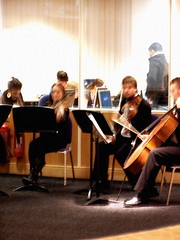
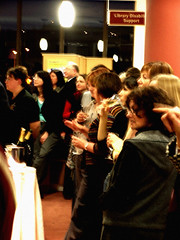
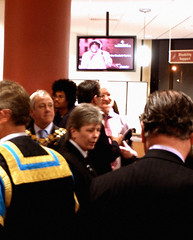
No sooner had Patrick walked in, he headed straight for the Info Desk…
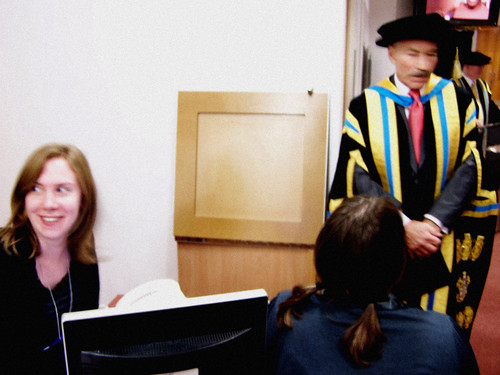
Lisa (left) is looking slightly surprised and that’s my better half Bryony sat on the right.

After an entertaining speech…

…Patrick unveiled the plaque…

…drinks were served…

…and he personally thanked the library staff for their hard work over summer…

I’d thoroughly recommend getting a string quartet to play in your library entrance — it definitely sets a nice ambience 🙂
OPAC keyword cloud
This is crying out to be done like the visual word map in AquaBrowser, but here’s a browseable tag cloud based on data from nearly 2 million keyword searches on our OPAC.
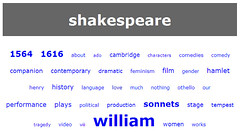
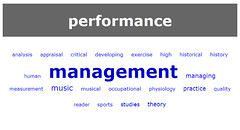
The code looks for other keywords that were entered as part of the same search (e.g. “ethics of nursing care”) to draw out the most commonly used words. For example, the most common keyword used with “performance” is “management”. The size of the word in the cloud is determined by how often it appears with the search keyword.
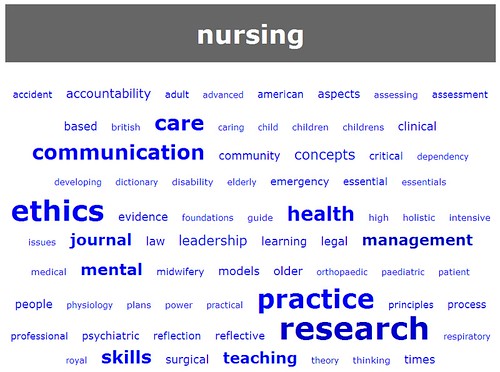
I’ve not removed keywords that generated zero search results, so the cloud for “acrobat” includes “abode”. (I’ve now removed zero result searches)
I’ll have to have a play to see if there’s a way of incorporating the cloud into the OPAC — for example, if you used a vague/general keyword such as “health“, then maybe the OPAC could suggest more specific searches for “health care”, “mental health” or “health promotion”?
Library Refurbishment
The entrance floor of the University of Huddersfield Library has been closed all summer for a major refurbishment. Today, we opened the doors to the “Student Centre” (the new name for the entrance floor) in time for Welcome Weekend and the start of Fresher’s Week.
Apart from the refurbishment, the new Student Centre hosts service points for the various Student Services which were previously housed elsewhere in the Central Services Building. This is great news for our students, as the majority of the services they require to support them during their studies are now in one place.
Even more exciting (for me, anyway!) — we get delivery of our new RFID book sorter on Monday morning 🙂
You can see all of the images from this morning in this Flickr set (or as a slideshow). Here are some of my favourites…
We’ve even managed to tweak our OPACs so that the screensaver matches the new colour scheme 🙂
